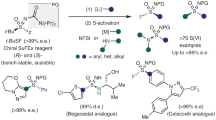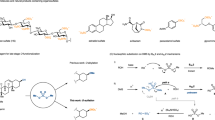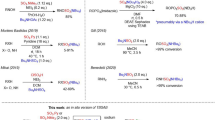Abstract
The present protocol details the synthesis of zinc bis(alkanesulfinate)s that can be used as general reagents for the formation of radical species. The zinc sulfinates described herein are generated from the corresponding sulfonyl chlorides by treatment with zinc dust. The products may be used crude, or a simple purification procedure may be performed to minimize incorporation of water and zinc chloride. Although the synthesis of the zinc sulfinate salts can generally be completed within 3 h, workup can take up to 24 h and purification can take up to 3 h. Following the steps in this protocol would enable the user to generate a small toolkit of zinc sulfinate reagents over the course of 1 week.
This is a preview of subscription content, access via your institution
Access options
Subscribe to this journal
Receive 12 print issues and online access
$259.00 per year
only $21.58 per issue
Buy this article
- Purchase on Springer Link
- Instant access to full article PDF
Prices may be subject to local taxes which are calculated during checkout



Similar content being viewed by others
References
Ji, Y. et al. Innate C–H trifluoromethylation of heterocycles. Proc. Natl. Acad. Sci. USA 108, 14411–14415 (2011).
Brückl, T., Baxter, R.D., Ishihara, Y. & Baran, P.S. Innate and guided C–H functionalization logic. Acc. Chem. Res. 45, 826–839 (2012).
Fujiwara, Y. et al. A new reagent for direct difluoromethylation. J. Am. Chem. Soc. 134, 1494–1497 (2012).
Fujiwara, Y. et al. Practical and innate carbon–hydrogen functionalization of heterocycles. Nature 492, 95–99 (2012).
Li, Z., Cui, Z. & Liu, Z.-Q. Copper- and iron-catalyzed decarboxylative tri- and difluoromethylation of α,β-unsaturated carboxylic acids with CF3SO2Na and (CF2HSO2)2Zn via a radical process. Org. Lett. 15, 406–409 (2013).
Cho, E.J. et al. The palladium-catalyzed trifluoromethylation of aryl chlorides. Science 328, 1679–1681 (2010).
Morimoto, H., Tsubogo, T., Litvinas, N.D. & Hartwig, J.F. A broadly applicable copper reagent for trifluoromethylations and perfluoroalkylations of aryl iodides and bromides. Angew. Chem. Int. Ed. 50, 3793–3798 (2011).
Fier, P.S. & Hartwig, J.F. Copper-mediated difluoromethylation of aryl and vinyl iodides. J. Am. Chem. Soc. 134, 5524–5527 (2012).
Zhao, Y. & Hu, J. Palladium-catalyzed 2,2,2-trifluoroethylation of organoboronic acids and esters. Angew. Chem. Int. Ed. 51, 1033–1036 (2012).
Han, C. & Buchwald, S.L. Negishi coupling of secondary alkylzinc halides with aryl bromides and chlorides. J. Am. Chem. Soc. 131, 7532–7533 (2009).
Zhou, Q. et al. Direct synthesis of fluorinated heteroarylether bioisosteres. Angew. Chem. Int. Ed. 52, 3949 (2013).
Weidner, J.P. & Block, S.S. Infrared spectra of zinc sulfinates. Appl. Spectrosc. 23, 337–341 (1969).
Deacon, G.B. & Cookson, P.G. The nature of sulphinate coordination in zinc and cadmium arenesulphinates. Inorg. Nucl. Chem. Lett. 5, 607–608 (1969).
Lindner, E., Vitzthum, G., Langner, D. & Lorenz, I.P. Metal-ligand bonding in sulfinato complexes of transition metals. Angew. Chem. Int. Ed. 9, 160–161 (1970).
Lindner, E., Frembs, D.W.R. & Krug, D. Gezielte synthese von sulfinato-O- und -S-komplexen einiger Übergangsmetalle, XI. Bindungsisomerie bei sulfinato-komplexen von zink(II). Chem. Ber. 108, 291–300 (1975).
Acknowledgements
The Baran research group works with Sigma-Aldrich in providing a portfolio of zinc-based reagents promoting difluoromethylation, trifluoromethylation, trifluoroethylation and isopropylation of aryl and heteroaryl motifs. This relationship does not constitute a competing financial interest. We thank T. Ryba and C. Thomas from Sigma-Aldrich for a donation of chemicals. Financial support for this work was provided by the US National Institutes of Health (research grant GM-073949 and a postdoctoral fellowship for R.D.B.), Pfizer (financial support and a fellowship for A.G.O.), the US-UK Fulbright Commission (postdoctoral fellowship for F.O.) and the Uehara Memorial Foundation (postdoctoral fellowship for Y.F.).
Author information
Authors and Affiliations
Contributions
F.O., R.D.B., A.G.O., J.A.D., Y.F. and P.S.B. designed the experiments; F.O., R.D.B., A.G.O., J.A.D. and Y.F. conducted the experiments; F.O., R.D.B., A.G.O., M.R.C., J.A.D., Y.F., Y.I. and P.S.B. analyzed the data and Y.I. and P.S.B. wrote the manuscript.
Corresponding author
Ethics declarations
Competing interests
The authors declare no competing financial interests.
Supplementary information
Supplementary Data
Supplementary information. X-ray structures of TFMS•THF complex and DFMS, elemental analyses for all desired products and determination of chloride incorporation. (PDF 1862 kb)
Rights and permissions
About this article
Cite this article
O'Hara, F., Baxter, R., O'Brien, A. et al. Preparation and purification of zinc sulfinate reagents for drug discovery. Nat Protoc 8, 1042–1047 (2013). https://doi.org/10.1038/nprot.2013.059
Published:
Issue Date:
DOI: https://doi.org/10.1038/nprot.2013.059
This article is cited by
-
A practical and catalyst-free trifluoroethylation reaction of amines using trifluoroacetic acid
Nature Communications (2017)
Comments
By submitting a comment you agree to abide by our Terms and Community Guidelines. If you find something abusive or that does not comply with our terms or guidelines please flag it as inappropriate.



